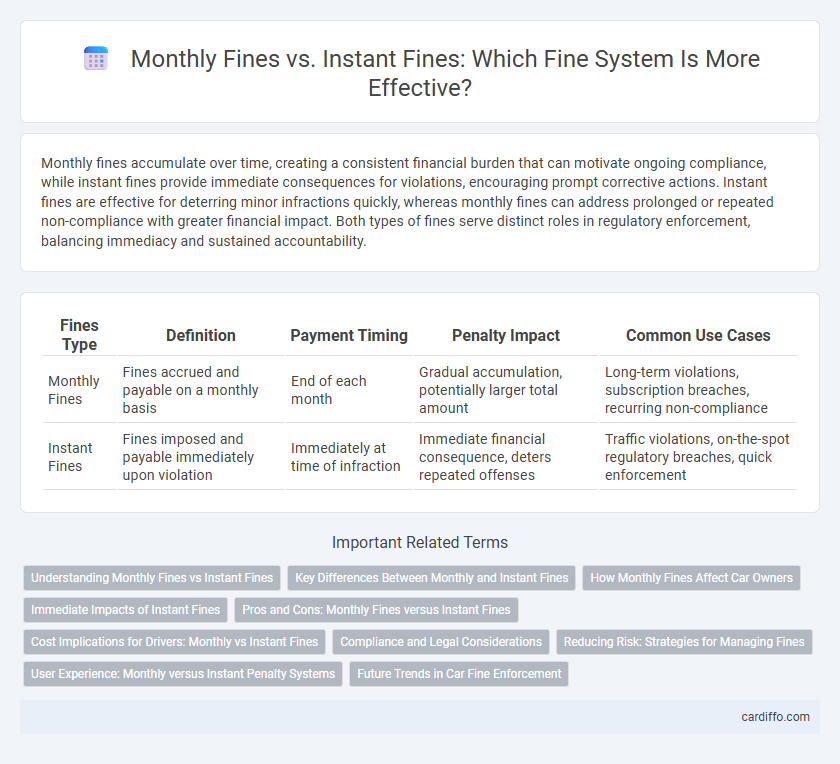Monthly fines accumulate over time, creating a consistent financial burden that can motivate ongoing compliance, while instant fines provide immediate consequences for violations, encouraging prompt corrective actions. Instant fines are effective for deterring minor infractions quickly, whereas monthly fines can address prolonged or repeated non-compliance with greater financial impact. Both types of fines serve distinct roles in regulatory enforcement, balancing immediacy and sustained accountability.
Table of Comparison
| Fines Type | Definition | Payment Timing | Penalty Impact | Common Use Cases |
|---|---|---|---|---|
| Monthly Fines | Fines accrued and payable on a monthly basis | End of each month | Gradual accumulation, potentially larger total amount | Long-term violations, subscription breaches, recurring non-compliance |
| Instant Fines | Fines imposed and payable immediately upon violation | Immediately at time of infraction | Immediate financial consequence, deters repeated offenses | Traffic violations, on-the-spot regulatory breaches, quick enforcement |
Understanding Monthly Fines vs Instant Fines
Monthly fines accumulate based on repeated or prolonged violations, leading to a cumulative financial penalty over time, while instant fines are immediate charges imposed right after a violation is detected. Understanding the distinction between these penalties is crucial for managing compliance, as monthly fines incentivize sustained adherence and instant fines serve as immediate deterrents. Businesses and individuals must evaluate the long-term cost implications of monthly fines versus the prompt impact of instant fines to ensure effective risk mitigation.
Key Differences Between Monthly and Instant Fines
Monthly fines are calculated based on the duration of the violation or non-compliance, accumulating penalties over a set period, while instant fines impose a fixed penalty immediately upon the infraction. Instant fines provide immediate deterrence and quicker enforcement, whereas monthly fines encourage prolonged compliance by linking financial consequences to ongoing behavior. The choice between monthly and instant fines depends on the regulatory goals, with instant fines promoting rapid correction and monthly fines addressing continuous violations.
How Monthly Fines Affect Car Owners
Monthly fines impose recurring financial burdens on car owners, often leading to accumulated debt if violations persist. This continuous penalty structure can strain personal budgets and affect credit scores, making it harder for owners to manage other expenses. Regular monthly charges also increase stress levels and incentivize timely compliance with traffic laws to avoid prolonged penalties.
Immediate Impacts of Instant Fines
Instant fines deliver immediate financial penalties that reinforce compliance more effectively than monthly fines, which accumulate over time without immediate consequences. This immediacy enhances behavioral change by linking violations directly to instant repercussions, increasing deterrence. Research indicates that the promptness of instant fines reduces repeat offenses significantly compared to delayed monthly penalty systems.
Pros and Cons: Monthly Fines versus Instant Fines
Monthly fines provide consistent revenue streams and encourage sustained compliance by imposing penalties over time, reducing the immediate financial burden on offenders. Instant fines offer swift enforcement and immediate deterrence, promoting quick behavioral correction but may cause financial hardship or resistance due to their abrupt nature. Balancing monthly fines and instant fines requires evaluating enforcement goals, offender capacity, and desired compliance outcomes for optimal effectiveness.
Cost Implications for Drivers: Monthly vs Instant Fines
Monthly fines often lead to higher overall costs for drivers due to accumulating penalties and potential interest charges, increasing financial burden over time. Instant fines provide immediate payment requirements, enabling drivers to settle dues quickly and possibly avoid additional fees or legal complications. Comparing cost implications, instant fines generally result in lower total expenses, while monthly fines risk escalating costs if left unpaid.
Compliance and Legal Considerations
Monthly fines provide a continuous incentive for sustained compliance, allowing organizations to address violations over time and reduce extended legal risks. Instant fines enforce immediate accountability, deterring infractions by imposing swift penalties that support strict adherence to regulatory standards. Legal frameworks often favor instant fines for clear-cut violations, while monthly fines offer flexibility for resolving ongoing compliance issues without escalating litigation.
Reducing Risk: Strategies for Managing Fines
Implementing instant fines accelerates consequences, reinforcing immediate compliance and reducing prolonged exposure to regulatory risks. Monthly fines, although cumulative, may delay corrective actions, increasing the likelihood of sustained non-compliance and financial penalties. Effective risk management involves balancing instant fines for swift deterrence and monthly fines for ongoing accountability, optimizing strategies to minimize organizational liabilities.
User Experience: Monthly versus Instant Penalty Systems
Monthly fines provide users with extended time to rectify violations, reducing immediate stress and allowing for better financial planning, which enhances overall user experience. Instant fines deliver immediate consequences, promoting quicker compliance but may lead to frustration due to sudden penalties disrupting users' routines. Balancing enforcement efficiency with user-friendly policies is crucial to optimize satisfaction and compliance rates.
Future Trends in Car Fine Enforcement
Future trends in car fine enforcement indicate a shift towards instant fines facilitated by advanced AI-powered traffic monitoring systems, enabling real-time violation detection and faster penalty issuance. Monthly fines, while still in use, may become less prevalent as instant fines improve compliance through immediate consequences and seamless digital payment options. Emerging technologies like blockchain and smart contracts are expected to enhance transparency and efficiency in the car fine enforcement ecosystem.
Monthly fines vs Instant fines Infographic

 cardiffo.com
cardiffo.com